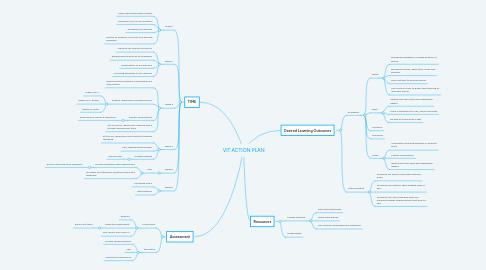
1. TIME
1.1. Week 1
1.1.1. Initial discussions with mentor
1.1.2. Refining focus of my quesiton
1.1.3. Assessing my learners
1.1.4. Mentor to observe my practice & provide feedback
1.2. Week 2
1.2.1. Observe my mentor's practice
1.2.2. Researching resources on feedback
1.2.3. Observation of my practice
1.2.4. Providing feedback to my learners
1.3. Week 3
1.3.1. Refine practice based on observations & discussions
1.3.2. Explicit unpacking of student goals,
1.3.2.1. Where am I?
1.3.2.2. Where am I going?
1.3.2.3. Where to next?
1.3.3. Mentor observations
1.3.3.1. Recording of lesson & reflection
1.3.4. Act on AITSL research to develop self & student assessment tools
1.4. Week 4
1.4.1. Act on my reflecitons and mentor/coaching feedback.
1.4.2. F&P assessments to begin
1.4.3. Guided reading
1.4.3.1. Record ings
1.5. Week 5
1.5.1. F&P
1.5.1.1. Provide feedback after assessment
1.5.1.1.1. Record and reflect on feedback
1.5.1.2. Strategic monitoring of question types and feedback
1.6. Week 6
1.6.1. Complete F&P's
1.6.2. Observations
2. Assessment
2.1. Summative
2.1.1. Reports
2.1.2. Essential Assessment
2.1.2.1. Pre & Post tests
2.1.3. F&P results from Term 2
2.2. Formative
2.2.1. Guided reading groups
2.2.2. F&P
2.2.3. Individual conferences
3. Desired Learning Outcomes
3.1. Academic
3.1.1. Baran
3.1.1.1. Recognise digraphs in middle position of words
3.1.1.2. Recognise nouns, adjectives, verbs and adverbs
3.1.1.3. Work actively to decode words
3.1.1.4. Use context clues to guess the meaning of unknown words.
3.1.2. Benji
3.1.2.1. Identify the main idea and supporting details
3.1.2.2. Make connections to self, world and texts
3.1.2.3. Be able to summarise a text
3.1.3. Corleone
3.1.4. Immanuel
3.1.5. Aiden
3.1.5.1. Completion and participation in learning tasks
3.1.5.2. Making connections
3.1.5.3. Identifying main idea and supporting details.
3.2. Metacognitive
3.2.1. Students are able to articulate learning goals
3.2.2. Students can identify their existing level of skill
3.2.3. Students can articulate how they are working towards achieving the next level of skill.
4. Resources
4.1. Guided Reading
4.1.1. Deconstructed texts
4.1.2. Word work games
4.1.3. F&P leveled comprehension questions

